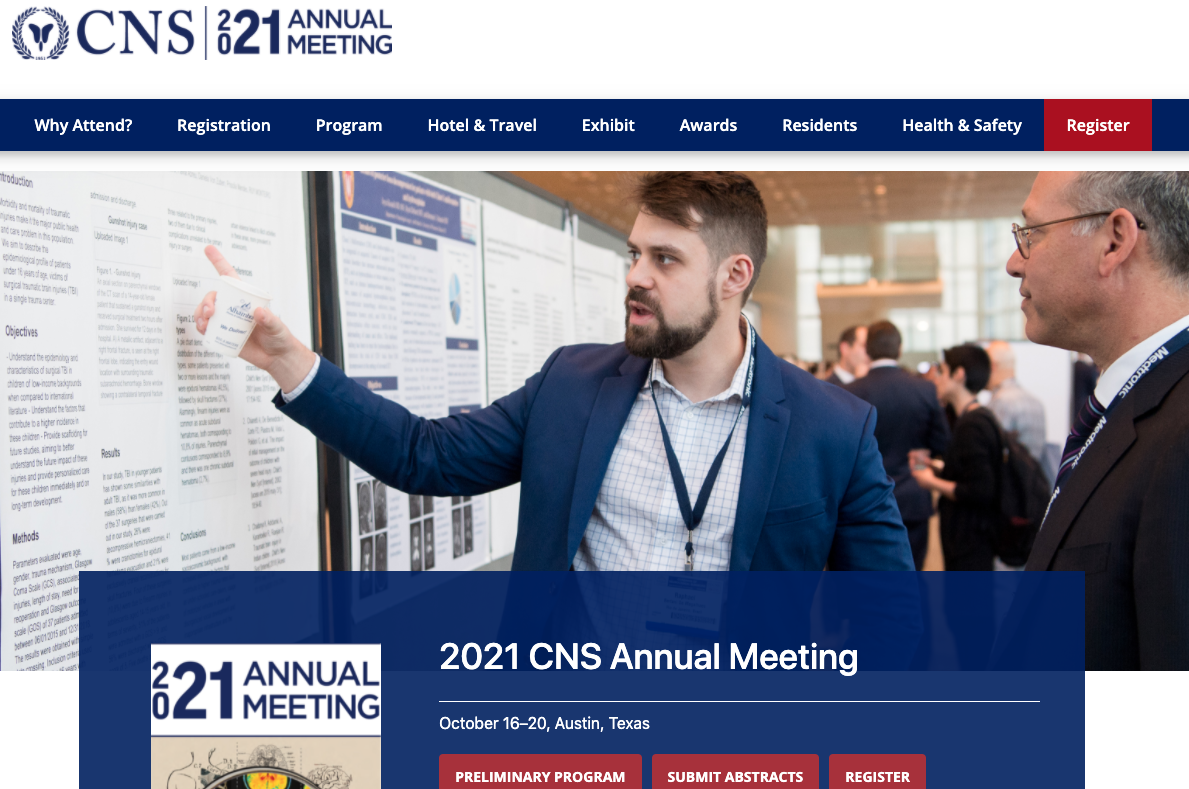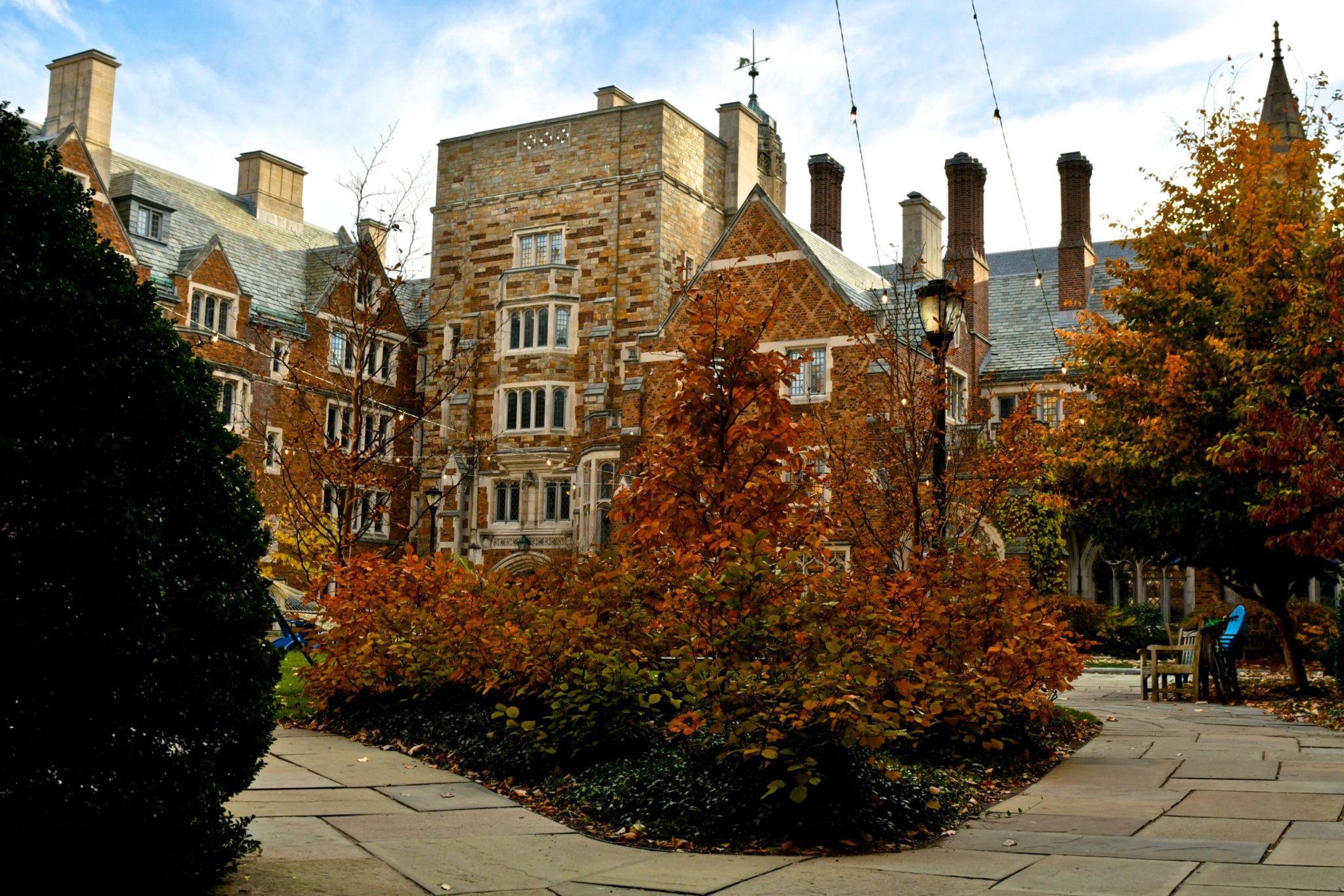X
X
Leaving Community
Are you sure you want to leave this community? Leaving the community will revoke any permissions you have been granted in this community.
No
Yes
X
Cannabis in NIF's Data Holdings
Cannabis in NIF's Data Holdings
NIF was asked to give the National Institutes on Drug Abuse a report of the state of the data holdings for one abused substance: Cannabis. The report is included below. The data reflect the state of NIF in early 2013, following the links will potentially lead users to updated numbers.
Within NIF many sources have information about cannabis or the endocanabinoid system (we did not include an analysis of the literature). These results have been broken down by the number, below (for an interactive graph click here and then select the Graph Filters Box).
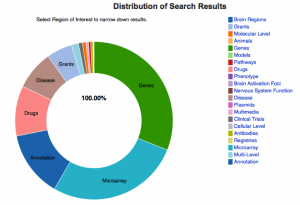
Genes
Looking at genes we find the two human genes CNR1 and CNR2, which are endocanabinoid receptors have these counterparts (CNRIP1, Cnr1, cnrip1, Cnr2, Cnrip1, and cnr1) in many other species including, mammals, birds, fish and tunicates. This indicates that the gene family is quite widespread.
Three clusters of genes have emerged based on the Homologene clustering algorithm. These gene families are for CNR1, CNR2 and the interacting protein called CNRIP1.
Drugs
The endocanabinoid receptors have several drugs (largely derived from THC) that interact with the receptors.
Drugbank, a leading source of drug information tells us that two small molecule drugs have been used to affect the endocannabinoid system.
Nabilone has been used largely as an anti-anxiety agent or an antiemetic. Nabilone is a cannabinoid with therapeutic uses. It is an analog of dronabinol (also known as tetrahydrocannabinol or THC), the psychoactive ingredient in cannabis. It is reserved for use in individuals who do not respond to the more commonly used anti-emetics.
Dronabinol has also been used as an antiemetic, but also analgesic, non-narcotic psychotropic drug and a hallucinogen. Marinol may have complex effects on the central nervous system (CNS), including cannabinoid receptors. Dronabinol may inhibit endorphins in the emetic center, suppress prostaglandin synthesis, and/or inhibit medullary activity through an unspecified cortical action.
The NIMH Chemical Synthesis and Drug Supply Program lists three more specific drugs including two specific antagonists and ChEBI lists 12 variants of THC, which have less associated data, but may be useful as highly experimental substances that may have some specificity as agonists or antagonists, see below.
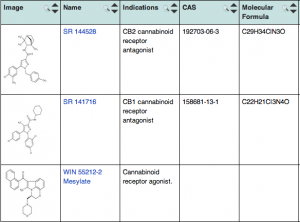
ChEBI compounds can be found below.
| CHEBI:219639 | C21H27F3O2 | 6,6,9-Trimethyl-3-(5,5,5-trifluoro-pentyl)-6a,7,10,10a-tetrahydro-6H-benzo[c]chromen-1-ol (5'-F3-delta8-THC) | |
| CHEBI:219603 | C21H29FO2 | 3-(5-Fluoro-pentyl)-6,6,9-trimethyl-6a,7,10,10a-tetrahydro-6H-benzo[c]chromen-1-ol (5'-F-delta8-THC) | |
| CHEBI:164237 | C21H30O2 | 6,6,9-Trimethyl-3-pentyl-6a,7,8,10a-tetrahydro-6H-benzo[c]chromen-1-ol (delta9-THC) | |
| CHEBI:566631 | C37H54O4 | alpha-Cadinyl delta9-Tetrahydrocannabinolate | |
| CHEBI:566632 | C37H54O4 | gama-Eudesmyl delta9-Tetrahydrocannabinolate | |
| CHEBI:566609 | C32H46O4 | alpha-Terpenyl delta9-Tetrahydrocannabinolate | |
| CHEBI:566610 | C32H46O4 | beta-Fenchyl delta9-Tetrahydrocannabinolate | |
| CHEBI:566618 | C32H46O4 | alpha-Fenchyl delta9-Tetrahydrocannabinolate | |
| CHEBI:566619 | C32H46O4 | epi-Bornyl delta9-Tetrahydrocannabinolate | |
| CHEBI:566620 | C32H46O4 | Bornyl delta9-Tetrahydrocannabinolate | |
| CHEBI:566630 | C32H46O4 | 4-Terpenyl delta9-Tetrahydrocannabinolate | |
| CHEBI:566636 | delta9-tetrahydrocannabinolic acid A |
Several of these compounds have been tested in various brain regions against the two known canabinoid receptors and from the Ki database we find that there is more data for CB1 (345), than the CB2 (173). Results are also organized by species and brain region with rat (296 results) and human (192) tested most frequently, followed by mouse (18), zebra finch (8) and newt (5) data.
Pathways
Wiki pathways, a collaborative platform from UCSF, lists the following pathways for CNR1 and CNR2:
Pathway Name
- GPCRs, Class A Rhodopsin-like (11)
- Small Ligand GPCRs (11)
- GPCRs, Other (3)
\t
\t
\t
Gene Symbol
- CNR2 (7)
- CNR1 (6)
\t
\t
Organism
- Mus musculus (5)
- Pan troglodytes (5)
- Rattus norvegicus (5)
- Homo sapiens (4)
- Bos taurus (2)
- Danio rerio (2)
- Gallus gallus (2)
\t
\t
\t
\t
\t
\t
\t
MultiMedia Information
Scientists studying endo- and exo-cannabinoids have written hundreds of blogs. Most of these focus on cannabis risks or the treatment of various disorders. A quick survey of these blogs indicates that there are links to Fragile X syndrome, multiple sclerosis, depression and decreases in intelligence on standardized tests. In addition, many scientists study the risk of motor vehicle accidents and possible interactions of mothers' canabinoid exposure and the proclivity of the offspring toward opiates, but surprisingly some have also reported a Marijuana-Borne Salmonella Outbreak and poisoning of workers from herbicides used to kill the plants.
A few video talks and interviews with leading researchers are also available (see several examples below).
_____________________________________________________________________________
| NIHVideo | Molecular Dissection of Cannabis Sensitivity in the Developing Brain | Tibor Harkany, PhD, Department of Medical Biochemistry and Biophysics, Karolinska Institute | |||||
| NIHVideo | New Developments in Cannabinoid Research: The Path from Plant to Modern Prescription Medicine | Guy, Geoffrey W. National Institutes of Health (U.S.) | |||||
| The Guardian: Science Videos | Cannabis 'more harmful to under-18s than adults' - video | ||||||
| NIHVideo | Brain Stress Systems and Addiction | Koob, George F. National Institutes of Health (U.S.) |
Funding Sources
Not surprisingly, NIDA funds most research on cannabis, but a few current grants are also given by NIMH, Alcohol, and NINDS. The breakdown of the number of recent grants by institute follows: national institute on drug abuse (375), national institute of mental health (26), national institute on alcohol abuse and (26), national institute on aging (11), and many others.
From older grants (Research Crossroads dataset covering both federal and foundation grants) we find that many institutes and foundation have given out grants related to the cannabinoids, including:
- National Institute on Drug Abuse(NIDA) (2937)
- National Center for Research Resources(NCRR) (152)
- National Institute of Neurological Disorders and Stroke(NINDS) (90)
- National Institute on Alcohol Abuse and Alcoholism(NIAAA) (64)
- National Institute of Mental Health(NIMH) (57)
- National Institute of General Medical Sciences(NIGMS) (52)
- National Cancer Institute(NCI) (33)
- National Eye Institute(NEI) (33)
- National Institute of Allergy and Infectious Diseases Extramural Activities(NIAID) (15)
- National Institute of Child Health & Human Development(NICHD) (15)
- Medical Research Council (UK) (12)
- National Heart, Lung, and Blood Institute(NHLBI) (12)
- CORDIS (11)
- National Institute of Environmental Health Sciences(NIEHS) (9)
- National Center for Complementary and Alternative Medicine(NCCAM) (7)
- National Institute of Diabetes and Digestive and Kidney Diseases (7)
- National Institute on Aging(NIA) (7)
- Fogarty International Center(FIC) (5)
\t
\t
\t
\t
\t
\t
\t
\t
\t
\t
\t
\t
\t
\t
\t
\t
\t
\t
Our search also reveals that even private funders like the American Diabetes Association also gave out a grant focusing on the therapeutic effects of endogenous cannabinoids in diabetic retinopathy.
Diseases and Clinical Studies
There are few diseases directly associated with Marijuana, however Pubmed health mentions four, including:
Marijuana intoxication
Aspergillosis, which is an infection or allergic response due to the Aspergillus fungus. Aspergillosis is caused by a fungus (Aspergillus), which is commonly found growing on dead leaves, stored grain, compost piles, or in other decaying vegetation. It can also be found on marijuana leaves. Although most people are often exposed to aspergillus, infections caused by the fungus rarely occur in people who have a normal immune system. The rare infections caused by aspergillus include pneumonia and fungus ball (aspergilloma).
Lung cancer - non-small cell, which mentions that “research shows that smoking marijuana may help cancer cells grow, but there is no direct link between the drug and developing lung cancer.”
Paraquat poisoning, which describes paraquat (dipyridylium) as a highly toxic weed killer once promoted by the United States for use in Mexico to destroy marijuana plants. Research found that this herbicide was dangerous to workers who applied it to the plants. This article discusses the health problems that can occur from swallowing or breathing in Paraquat.
NIF searches across two sources of clinical data, and the US based ClinicalTrials.gov contains information about 294 clinical trials, but the European based EU Clinical Trials Register finds only 27 additional trials. Below you can find the main conditions, interventions and sponsors for the clinical trials, with numbers indicating the number of clinical trial results.
Conditions
- Marijuana Dependence (15)
- Marijuana Abuse (13)
- Multiple Sclerosis (11)
- Cannabis Dependence (10)
- Healthy (8)
- Marijuana Smoking (6)
- Pain (5)
- Schizophrenia (4)
- Schizophrenia;Schizoaffective Disorder (4)
- Substance-Related Disorders
\t
\t
\t
\t
\t
\t
\t
\t
\t
\t
Intervention
- Behavioral: Behavior Therapy (6)
- Drug: Dronabinol (6)
- Drug: Cannabis (4)
- Drug;Drug: Sativex®;Placebo (4)
- Drug: GW-1000-02 (3)
- Drug: Nabilone (3)
- Drug: Smoked Cannabis (3)
- Drug;Drug: GW-1000-02;Placebo (3)
\t
\t
\t
\t
\t
\t
\t
\t
Sponsored By
- National Institute on Drug Abuse (NIDA); NIH (23)
- GW Pharmaceuticals Ltd.; Industry (15)
- New York State Psychiatric Institute;National Institute on Drug Abuse (NIDA); Other;NIH (9)
- Center for Medicinal Cannabis Research; Other (7)
- National Institute of Mental Health (NIMH); NIH (6)
- Yale University; Other (6)
\t
\t
\t
\t
\t
\t
Inference Data
The Clinical Toxogenomics Database (CTD) includes data about genes, pathways and diseases that have been found to be statistically associated with cannabinoids. The data are not from direct assertions, so they should be taken with a certain degree of skepticism. However, possibly interesting interactions with the following genes, diseases and pathways have been asserted.
Genes:
- AKT1 (580)
- TNF (414)
- ABCB1 (400)
- SCARB1 (146)
- IL1B (144)
- IFNG (140)
- CNR1 (139)
- VEGFA (110)
- FDFT1 (104)
- HMOX1 (100)
- PTGS2 (97)
\t
\t
\t
\t
\t
\t
\t
\t
\t
\t
\t
Diseases
- Marijuana Abuse (1512)
- Breast Neoplasms (74)
- Prostatic Neoplasms (69)
- Stomach Neoplasms (55)
- Lung Neoplasms (47)
- Carcinoma, Hepatocellular (45)
- Myocardial Ischemia (43)
- Schizophrenia (43)
- Cocaine-Related Disorders (39)
- Liver Cirrhosis, Experimental (37)
\t
\t
\t
\t
\t
\t
\t
\t
\t
\t
Pathways
- Signal Transduction (11)
- Immune System (9)
- Disease (8)
- Membrane Trafficking (6)
- Metabolism (6)
- Neuronal System (5)
- Glioma (4)
- Hemostasis (4)
- Muscle contraction (4)
- Neurotrophin signaling pathway (4)
\t
\t
\t
\t
\t
\t
\t
\t
\t
\t
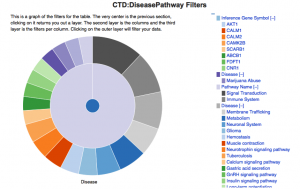
Microarray and Gene Expression Data
The Gene Expression Omnibus (GEO) contains data from 5 studies having to do with cannabinoids.
One of those studies was analyzed in significant detail by Gemma, which tells us that the study which specifically targeted an animal model for cutaneous contact hypersensitivity, showed that mice lacking both known cannabinoid receptors display exacerbated allergic inflammation. The study looked at CNR knockout mice and the main experimental factors were dinitrofluorobenzene vs. Control_group, and the Cnr1-/-/Cnr2-/- vs. C57BL/6J (knockout vs control).
The drug related gene database, reports on several studies including a heroin withdrawl / cannabidol withdrawl interaction study showing some interactions in the caudoputamen. The brain regions, experimental conditions and organisms most commonly studied are listed below:
Brain Region
- Anterior prefrontal cortex (556)
- Dorsolateral caudoputamen (8)
- Medial caudoputamen (8)
- Mid-lateral caudoputamen (8)
- CA1 stratum lacunosum moleculare (5)
- CA1 stratum oriens (5)
- CA1 stratum radiatum (5)
- CA3 stratum lucidum (5)
- CA3 stratum oriens (5)
- CA3 stratum radiatum (5)
\t
\t
\t
\t
\t
\t
\t
\t
\t
\t
Exp vs Control
- Cocaine + THC + PCP vs. Control (139)
- Cocaine vs. Control (139)
- PCP vs. Control (139)
- THC vs. Control (139)
- Delta9 THC vs. 1:1:18 solution of ethanol, emulphor, and saline (17)
- Alpha7 nicotinic acetylcholine + cannabinoid receptor 1 vs. Alpha7 nicotinic acetylcholine (9)
\t
\t
\t
\t
\t
\t
Organism
- Human: , 13-64 years Adolescent - Adult human (556)
- Sprague Dawley Rat: Male, Adult 200-250 g (43)
- Long Evans rat Rat: Male, 230-250 g at the beginning of the experiment (30)
- Mouse: , (17)
- Sprague Dawley Rat: Male, Adult rat 380-410 g (2)
\t
\t
\t
\t
\t
Protocol Type
- dna microarray (558)
- immunohistochemistry (47)
- in situ hybridization / immunohistochemistry (18)
- in situ hybridization / double in situ hybridization (16)
- in situ hybridization /double in situ hybridization (9)
\t
\t
\t
\t
\t
In mice, the brain structures that express cnr1 and cnr2, based on data from the mouse genome informatics database, the alen brain atlas and gensat are:
- hypothalamus (10)
- olfactory bulb (10)
- thalamus (10)
- cerebellum (9)
- cerebral cortex (9)
- midbrain (9)
- pons (8)
- amygdala (7)
- hippocampus (7)
- pallidum (7)
- hippocampal formation (6)
\t
\t
\t
\t
\t
\t
\t
\t
\t
\t
\t
- lateral septal complex (6)
- anterior olfactory nucleus (5)
- basal ganglia (5)
- corpus striatum (5)
- diencephalon (5)
- entorhinal cortex (5)
- globus pallidus (5)
- hindbrain (5)
- inferior colliculus (5)
\t
\t
\t
\t
\t
\t
\t
\t
\t
Most common assays are:
- rt-pcr (976)
- bac-cre recombinase driver (38)
- rna in situ hybridization (34)
- rna in situ (26)
\t
\t
\t
\t
The age of the organism:
- postnatal week 6-8 (732)
- postnatal (244)
- adult (53)
- embryonic day 14.5 (26)
- p7 (19)
\t
\t
\t
\t
\t
Brain Volume and Brain Activation Foci Data
Based on a publication in 2010, the cerebellar volume of marijuana abusers of 18 years of age appears to be significantly smaller than the norm. The norm is established by looking at the volumes reported from many publications.
The brain activation foci from SumsDB involved in marijuana use or abuse are shown as gray dots on the brain below. Each gray dot represents a coordinate from a study cataloged by SumsDB that involves cannabis. These have been pulled from the WebCaret software, from the laboratory of David VanEssen, and are accessible by clicking the “View on Brain” button within the SumsDB data result. Below, we are showing several views of the same result set, because not all points are visible from any one view of the brain, suggesting that there is no unified brain region involved cannabis abuse rather many regions are involved.

Medial View
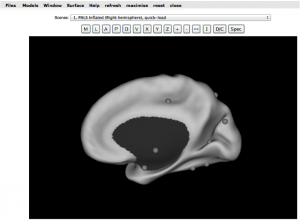
Posterior View

Imaging Data
The Cell Image Library has several data sets from Margaret I. Davis, mainly of interneurons expressing EGFP from the 5HT3 receptor promoter (Tg(Htr3a-EGFP)DH30Gsat, www.gensat.org) colabelled for the CB1 cannabinoid receptor.
The image below is from the pyramidal cell layer in hippocampal CA1.
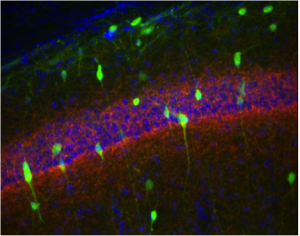
The figures show the distribution of interneurons expressing EGFP from the 5HT3 receptor promoter (Tg(Htr3a-EGFP)DH30Gsat, www.gensat.org) in the dorsal hippocampus colabelled for the CB1 cannabinoid receptor (red) and counterstained with DAPI (blue) to show the cell layers. In this experiment EGFP expression was amplified with chicken anti-GFP (Abcam, 1:2000); cell bodies and fibers are present throughout all layers of the hippocampus but enriched in the hilus and stratum lacunosum moleculare (see associated images). CB1 immunoreactivity (L15 rabbit polyclonal 1:200, K. Mackie) is prominent in the terminals of basket cells synapsing in the pyramidal cell layer. CB1 is also enriched in axons with distinct intensities in the inner and outer molecular layer of the dentate gyrus. CB immunoreactivity is also present in the stratum radiatum and stratum lacunosum moleculare.
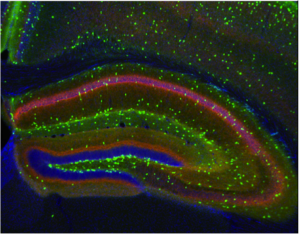
The data above can be complemented by 168 images gathered by Gensat from this mouse, generated by that project.
Resources
Animals, antibodies, databases as well as a game useful for teaching undergraduates are available from various sources.
The mouse line generated by Gensat (images above) is now available from the MMRRC resource, where two founder lines of knock out mice are available. The International Mouse Resource Center (IMSR) lists several other mice that may be available to the research community.
The Antibody Registry, our in house antibody aggregator, which aims to serve the scientific community by providing a set of unique identifiers for commercial and non-commercial antibody reagents, lists 242 antibody reagent offerings related to cannabinoids from over 10 vendors.
The NIF registry does not encode many resources that are specifically devoted to cannabinoids, but does note that several resources mention cannabis in their description including:
University of California at San Diego, Center for Medicinal Cannabis Research Resource Type: institutional portal
The Center for Medicinal Cannabis Research (CMCR) will conduct high quality scientific studies intended to ascertain the general medical safety and efficacy of cannabis products and examine alternative forms of cannabis administration. The Center will be seen as a ... See full record: nif-0000-10503
Mouse Party Resource Type: training material, video
Mouse Party is an interactive website that teaches how various drugs disrupt the synapse by taking a look inside the brains of mice on drugs! Every drug of abuse has its own unique molecular mechanism. Where applicable, this presentation primarily depicts how drugs... See full record: nif-0000-00429
SPROUTS- Structural Prediction for Protein Folding Utility System Resource Type: database, data analysis service
SPROUTS is a database of predicted protein folding related data. It was designed to gather all the results from a study concerning the comparison between tools devoted to the prediction of stability changes upon point mutations. The second aim of this database is... See full record: nif-0000-03491
Universal Virus Database Resource Type: web accessible database
The ICTVdB is a dynamic database containing information about viruses of animals, plants, bacteria, and fungi. Though initially designed for taxonomic (or classification) research, the ICTVdB has evolved to become a major reference resource and research tool. The ... [more] See full record: nif-0000-21213
Psychoactive Drug Screening Program Ki Database Resource Type: database, data repository
Database of information on the abilities of drugs to interact with an expanding number of molecular targets. It serves as a data warehouse for published and internally-derived Ki, or affinity, values for a large number of drugs and drug candidates at an expanding n... [more] See full record: nif-0000-01866
Subviral RNA Database Resource Type: database
The Subviral RNA database facilitates the research and analysis of viroids, satellite RNAs, satellite viruses, the human hepatitis delta virus, and related RNA sequences. It integrates a large number of Subviral RNA sequences, their respective RNA motifs, analysis ... [more] See full record: nif-0000-03507
X


